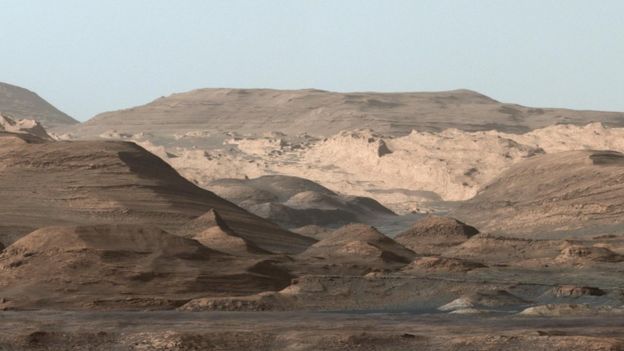Nasa's Perseverance rover, due to launch to Mars this summer, will search an ancient crater lake for signs of past life. But if biology ever emerged on the Red Planet, how will scientists recognise it? Here, deputy project scientist Ken Williford explains what they're looking for.
Today, Mars is hostile to life. It's too cold for water to stay liquid on the surface, and the thin atmosphere lets through high levels of radiation, potentially sterilising the upper part of the soil.
But it wasn't always like this. Some 3.5 billion years ago or more, water was flowing on the surface. It carved channels still visible today and pooled in impact craters. A thicker carbon dioxide (CO2) atmosphere would have blocked more of the harmful radiation.
Water is a common ingredient in biology, so it seems plausible that ancient Mars once offered a foothold for life
In the 1970s, the Viking missions carried an experiment to look for present-day microbes in the Martian soil. But the results were judged inconclusive.

In the early 2000s, Nasa's Mars Exploration Rovers were tasked with "following the water". Opportunity and Spirit found extensive geological evidence for the past presence of liquid water.
The Curiosity rover, which touched down in 2012, found the lake that once filled its landing site at Gale Crater could have supported life. It also detected organic (carbon-containing) molecules that serve as life's building blocks.
Now, the Perseverance rover will explore a similar environment with instruments designed to test for the signatures of biology.
"I would say it's the first Nasa mission since Viking to do that," said Ken Williford, the mission's deputy project scientist, from Nasa's Jet Propulsion Laboratory (JPL) in Pasadena, California.
"Viking was the search for extant life - that is, life that might be living on Mars today. Whereas the more recent Nasa approach has been to explore ancient environments because the data we have suggest that the earliest history of the planet tells us that Mars was most habitable during its first billion years."
In the early 2000s, Nasa's Mars Exploration Rovers were tasked with "following the water". Opportunity and Spirit found extensive geological evidence for the past presence of liquid water.
The Curiosity rover, which touched down in 2012, found the lake that once filled its landing site at Gale Crater could have supported life. It also detected organic (carbon-containing) molecules that serve as life's building blocks.
Now, the Perseverance rover will explore a similar environment with instruments designed to test for the signatures of biology.
"I would say it's the first Nasa mission since Viking to do that," said Ken Williford, the mission's deputy project scientist, from Nasa's Jet Propulsion Laboratory (JPL) in Pasadena, California.
"Viking was the search for extant life - that is, life that might be living on Mars today. Whereas the more recent Nasa approach has been to explore ancient environments because the data we have suggest that the earliest history of the planet tells us that Mars was most habitable during its first billion years."








.webp)
















